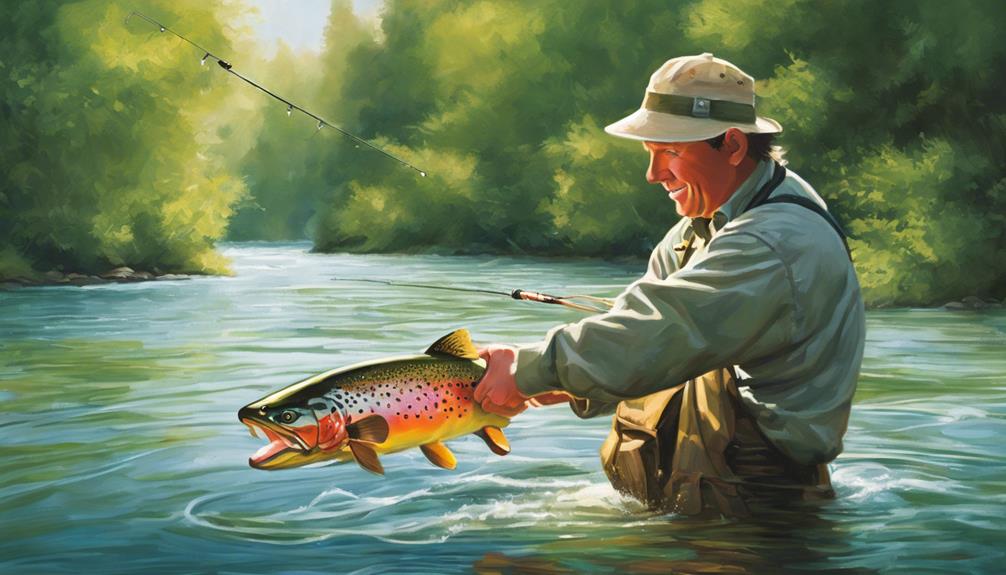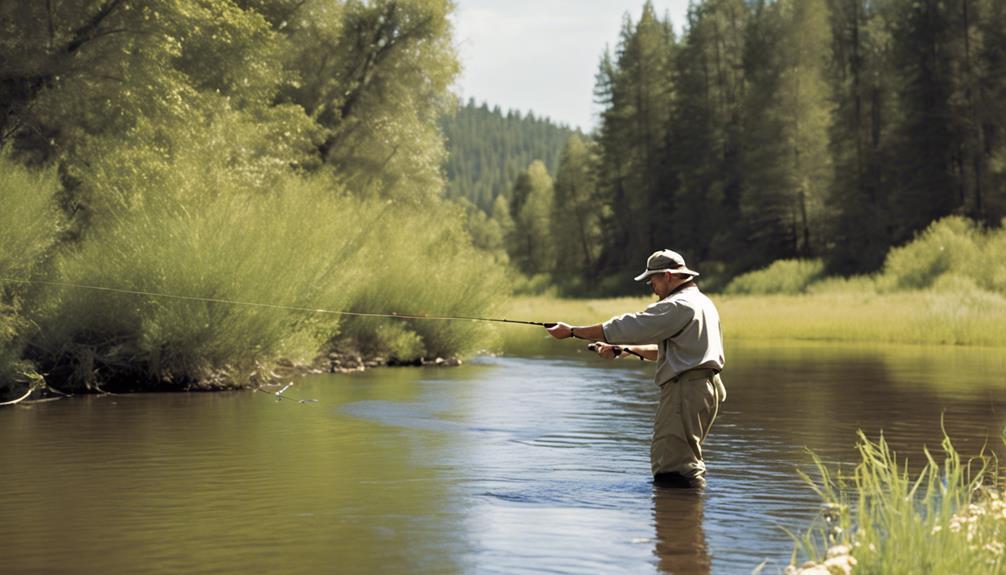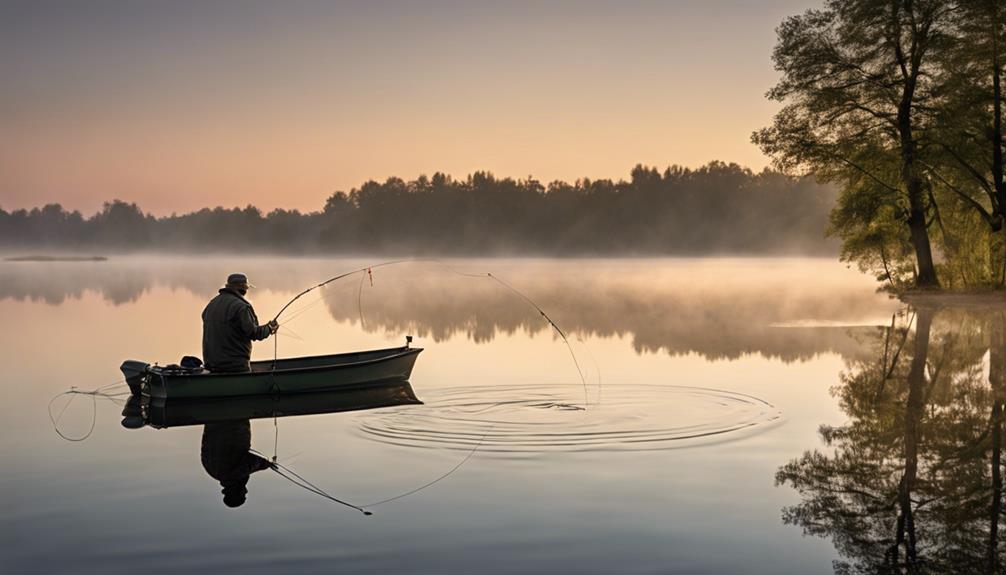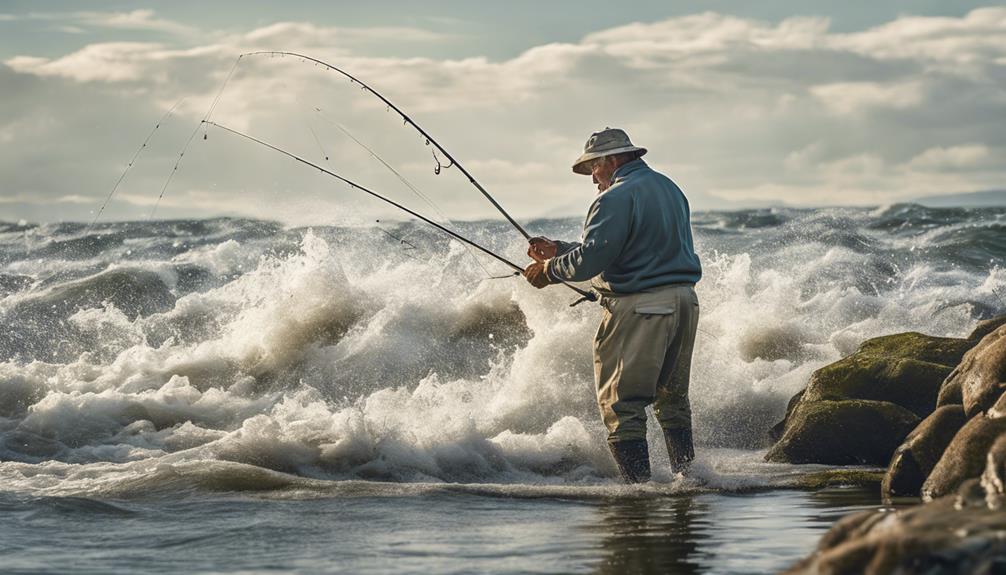In the vast river of fly fishing techniques, novices often find themselves lost without a paddle. But fear not, as we're here to help you navigate the waters and steer you towards success.
Imagine casting your line with precision and finesse, each movement orchestrated like a symphony. These ten essential techniques will be your compass in the world of fly fishing, guiding you toward becoming a skilled angler.
So, are you ready to unlock the secrets that will elevate your fly fishing game to the next level?
Selecting the Right Gear
When gearing up for fly fishing, ensure you have the right equipment to maximize your experience on the water. Proper sizing of your gear is crucial for comfort and efficiency while fishing. Make sure your waders fit well to prevent any discomfort or restriction of movement. Ill-fitting waders can quickly turn a pleasant fishing trip into a miserable experience. Additionally, check that your wading boots are the correct size to provide stability and support on slippery rocks.
Gear maintenance is another essential aspect to consider when preparing for fly fishing. Before heading out, inspect your fly rod for any signs of damage such as cracks or loose guides. Clean your rod with a damp cloth after each use to prevent dirt and grime buildup. It's also a good idea to check your fly line for any nicks or tangles that could affect your casting ability. Properly maintaining your gear won't only prolong its lifespan but also ensure optimal performance on the water.
Understanding Basic Casting Techniques
To master fly fishing, understanding basic casting techniques is essential for effectively presenting your fly to the fish. Line control plays a crucial role in fly fishing. By mastering line control, you can manipulate the movement of your fly in the water, imitating the natural behavior of insects to attract fish. Proper line control also helps in setting the hook when a fish strikes, increasing your chances of a successful catch.
Casting accuracy is another key aspect of fly fishing. The ability to accurately place your fly in the desired location is vital for enticing fish to bite. Practice your casting technique to improve accuracy, focusing on smooth movements and precise placements. Remember to consider factors like wind direction and current speed, adjusting your casting technique accordingly for better results.
When casting, pay attention to your rod's position and the timing of your movements. Keep a firm grip on the rod and maintain a smooth, controlled casting motion to prevent tangles and ensure a clean presentation of your fly. With practice, you'll develop the muscle memory needed to execute accurate casts consistently.
Identifying Insect Behavior
Mastering fly fishing techniques involves not only understanding basic casting techniques but also identifying insect behavior to effectively mimic natural prey and attract fish. Insect identification and selecting the right fly are crucial aspects of successful fly fishing. Observing the water and understanding bug behavior can greatly enhance your fishing experience.
To start, learning to identify different types of insects is essential. By recognizing the insects present in the area where you're fishing, you can choose a fly pattern that closely resembles the natural insects that fish are feeding on. This increases the likelihood of a fish taking your fly.
Furthermore, observing the water for insect activity is key. Look for signs such as insects skittering on the surface, fish rising to feed, or ripples indicating insects breaking through the surface tension. Understanding when and where insects are most active can help you decide which fly to use and where to cast it.
Mastering the Art of Presentation
Understanding how to present your fly effectively is crucial for enticing fish to strike. Mastering the art of fly presentation requires finesse and attention to detail. Here are three key tips to help you improve your presentation skills:
- Focus on Fly Presentation: Pay close attention to how your fly lands on the water. Aim for a gentle touch, mimicking the natural behavior of insects. Avoid splashes that can startle fish. Practice different casting techniques to achieve a delicate presentation that will attract fish without alerting them to any potential danger.
- Emphasize Accuracy: Precision in presentation is key to success in fly fishing. Work on casting accuracy by practicing your casting technique regularly. Consider the wind direction and speed when casting to ensure your fly lands where you intend it to. A well-placed fly is more likely to entice a fish to strike, so take the time to hone your accuracy skills.
- Adjust to Conditions: Be adaptable in your presentation approach based on the fishing conditions. Different situations may call for varying techniques, such as casting under overhanging branches or adjusting your casting angle to work around obstacles. By being flexible and willing to experiment with different presentation methods, you can increase your chances of a successful catch.
Learning to Mend Your Line
For novices in fly fishing, mastering the technique of mending your line is crucial for achieving a natural drift and improving your chances of enticing fish to bite. Line control and drift management are essential aspects of successful fly fishing. When you cast your line onto the water, it's important to pay attention to how the current is affecting the positioning of your line. This is where mend timing plays a significant role.
To effectively mend your line, you need to make adjustments to prevent drag. Drag occurs when the current pulls your line, causing your fly to move unnaturally in the water. To avoid this, you must mend your line by lifting it off the water slightly and repositioning it to ensure a drag-free drift. The key is to mend the line before it starts affecting the presentation of your fly.
Another critical factor in mending your line is managing line tension. By mending your line properly, you can reduce tension and prevent your fly from being dragged across the water's surface. Maintaining the right amount of tension allows your fly to move naturally with the current, increasing its appeal to feeding fish.
Practice mending your line regularly to become more proficient at this essential fly fishing skill. With proper line control and timely mends, you'll notice a significant improvement in your ability to present your fly naturally and entice fish to strike.
Setting the Hook Properly
To effectively set the hook while fly fishing, ensure you maintain a firm but controlled tension on your line. Setting the hook is a crucial skill that can make the difference between a successful catch and a missed opportunity.
Here are some key tips to help you improve your hook-setting technique:
- Timing is Key: One of the most critical aspects of setting the hook is timing. You need to wait for the right moment before making a swift and decisive hook set. If you strike too early, you may pull the fly away from the fish, and if you strike too late, the fish might spit the fly out. Pay close attention to any movement or hesitation in the fish's behavior to anticipate the perfect moment to set the hook.
- Maintain Optimal Tension Levels: Keeping the right amount of tension on your line is essential. Too much tension can cause the fish to feel resistance and let go of the fly, while too little tension may result in a weak hook set. Practice finding the balance between maintaining a firm connection to the fish and allowing it to move naturally before setting the hook.
- Be Prepared for a Quick Response: When you feel a fish strike, be ready to react promptly. A quick and assertive hook set with the correct timing and tension can greatly increase your chances of successfully hooking the fish. Stay focused and be prepared to set the hook at a moment's notice.
Playing and Landing Fish

When playing and landing fish while fly fishing, ensure you maintain a steady tension on the line to prevent the fish from breaking free. As the fish fights against the line, keep the rod tip up and angled towards the fish to absorb its movements. This helps tire out the fish more quickly and reduces the risk of it escaping. When handling the fish, wet your hands before touching it to protect its delicate scales and skin. Avoid squeezing the fish tightly and support its body properly to minimize harm.
During the fish fighting process, be patient and let the fish make its runs while maintaining gentle pressure to guide it towards you. If the fish makes a sudden dash, allow the line to slip through your fingers to prevent it from snapping. Once the fish is tired out, carefully bring it closer for netting. When using a net, lead the fish into the net headfirst to prevent it from swimming away.
After landing the fish, be quick but gentle in removing the hook to release it back into the water swiftly. Avoid keeping the fish out of the water for extended periods to ensure its well-being. By mastering these fish handling and netting techniques, you can enhance your fly fishing experience while responsibly catching and releasing fish.
Practicing Proper Catch and Release
Ensure the safe return of the fish to its environment by mastering the proper catch and release techniques in fly fishing. When practicing catch and release, you play a crucial role in the conservation efforts of fish populations. Follow these essential guidelines to improve the chances of survival for the fish you catch:
- Handling fish: When handling a fish you intend to release, make sure your hands are wet to avoid removing the fish's protective slime layer, which can leave them vulnerable to infections. Support the fish gently and avoid squeezing it tightly. If the fish has swallowed the hook deeply, consider cutting the line rather than causing further harm by trying to remove it forcefully.
- Conservation efforts: By practicing catch and release, you contribute to the conservation of fish populations and their habitats. Returning the fish unharmed ensures that it can continue to thrive and reproduce, maintaining the delicate balance of aquatic ecosystems. Additionally, following catch and release best practices helps preserve the sport of fly fishing for future generations, allowing others to enjoy the thrill of angling in the years to come.
- Responsible angling: Remember that responsible angling goes beyond catching fish—it involves ethical practices that prioritize the well-being of the fish. Be mindful of local regulations, use barbless hooks to minimize harm, and release fish promptly to reduce stress and increase their chances of survival. By adopting these practices, you can savor the joys of fly fishing while safeguarding the aquatic environment for years to come.
Frequently Asked Questions
How Can Novices Prevent Their Line From Getting Tangled While Fly Fishing?
When you're out fly fishing, preventing your line from tangling is crucial. Start by mastering line management techniques such as keeping your line taut and controlling the slack.
Focus on improving your casting accuracy to avoid unnecessary loops and tangles. Make sure your knots are secure and practice proper fly selection to reduce the chances of snags.
With practice and attention to detail, you'll soon be able to minimize tangles and maximize your fishing success.
What Are Some Common Mistakes Beginners Make When Fly Fishing and How Can They Avoid Them?
When fly fishing, beginners often make mistakes like improper casting techniques and misreading fish behavior. To avoid these errors, focus on mastering proper casting techniques.
Practice your casting in different conditions to improve accuracy. Additionally, study fish behavior to understand their feeding patterns and habitats.
How Important Is It to Match the Hatch When Fly Fishing and How Can Beginners Learn to Do so Effectively?
When fly fishing, matching the hatch is crucial for success. To do this effectively, beginners should focus on hatch matching tactics and select flies that closely resemble the insects on the water.
What Are Some Advanced Techniques That Novices Can Work Towards Mastering After They Have Gained More Experience?
As you gain more experience, you can start honing advanced casting techniques and refining your fly selection strategies. These skills will elevate your fly fishing game, allowing you to cast with precision and choose the right fly for different conditions.
Practice various casting methods like double hauling or reach casting to improve your accuracy. Experiment with different fly patterns and sizes to match the hatch effectively and attract more fish.
Are There Any Specific Safety Tips That Beginners Should Keep in Mind While Fly Fishing?
When fly fishing, safety precautions are crucial. Always wear proper gear like waders and a life jacket. Be aware of your surroundings and potential hazards. Practice casting away from others to avoid accidents.
Conclusion
Now that you've learned the 10 best fly fishing techniques for novices, it's time to get out on the water and put your skills to the test.
Remember to select the right gear, practice your casting techniques, and pay attention to insect behavior.
With patience and practice, you'll soon be reeling in plenty of fish and enjoying the peaceful serenity of fly fishing.
Happy fishing!



